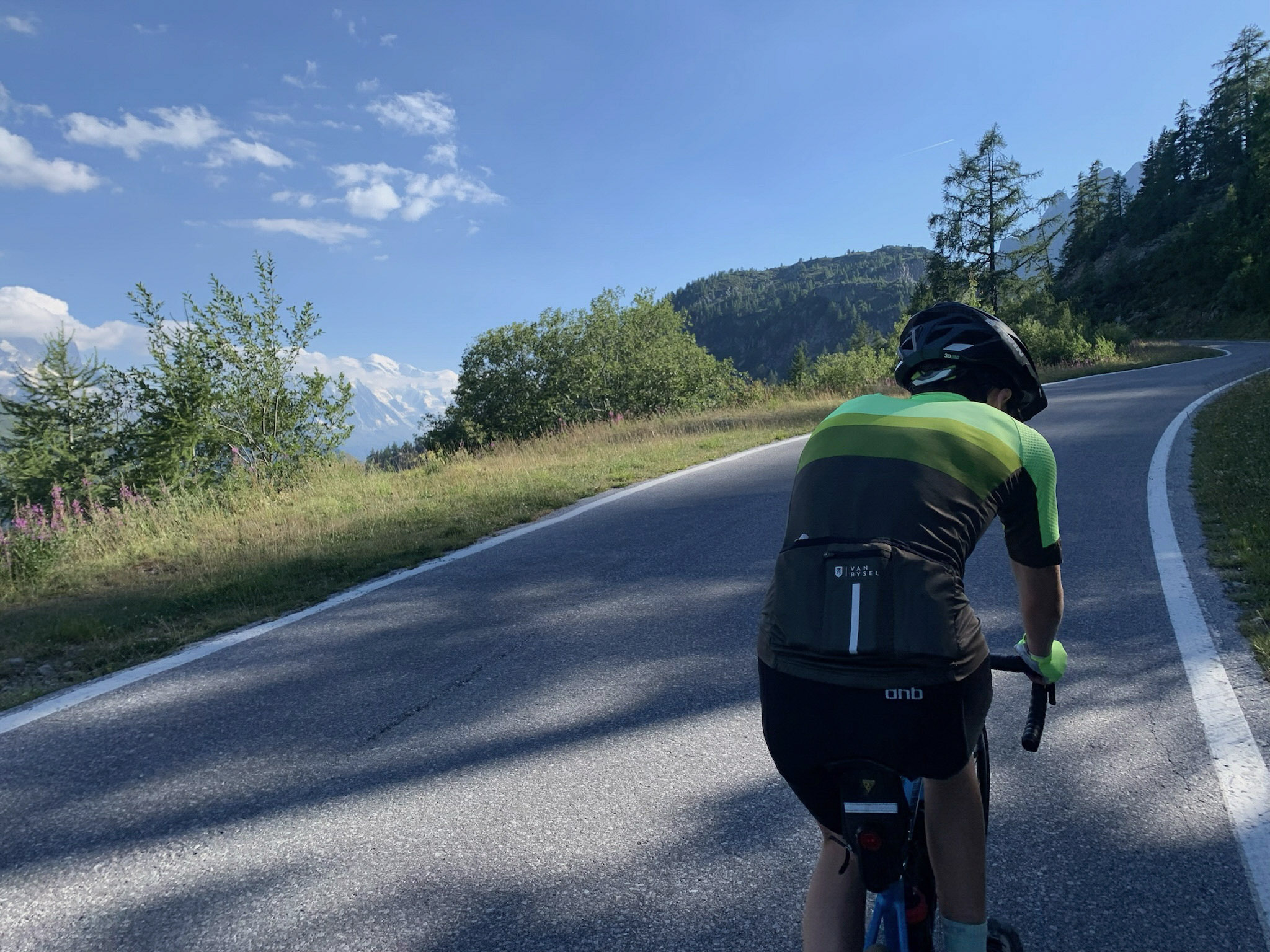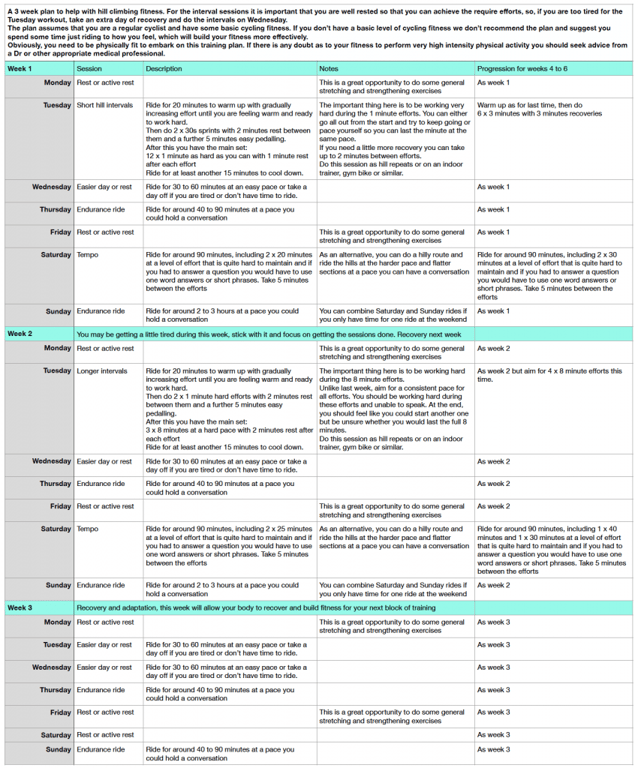How can I get better at cycling up hills?

I am often asked how cyclists can get better at cycling uphills, so I gave the problem some thought, did a bit of additional research and decided to write an article to explain my findings.
So, how can I get better at cycling up hills? In most cases, the best way to get better at cycling up hills is to improve your cycling fitness using a combination of harder efforts and endurance rides. The speed at which you can ride up hills is mostly determined by your fitness, for short hills or off-road having a bit more strength also helps.
Many cyclists build their fitness by going out for bike rides for an hour or so, where their pace is dictated by their friends, the terrain or how they feel. This is a great way to get fit, particularly when you start out and any exercise will make you fitter and stronger. However, with a little thought and by making some small changes to incorporate a few more focused efforts into your riding, it is amazing how quickly you can gain fitness and get faster.
Training to get better at riding hills requires that you work at different intensities, partly because hills come in many shapes and sizes but also because our bodies respond to a variety of stimuli. I have included an example plan later on that you can use as it is or modify to suit your needs but before that, here is some explanation of how things work.
Getting better at hills
You may find that you are better at certain types of hills than others, for example you might be good at short hills because you have good powers but find longer hills a struggle because you can’t sustain the pace. Alternatively, you might find you struggle with a fast pace but you can keep going on longer hills or even catch up with your group as they slow down on longer climbs.
This is partly due to riding at a pace that you can sustain for the length of the hill and that doesn’t make you too tired for what is to come in the rest of the ride but if you are riding in a group the pace is often dictated by the group. To get better, you need to feel more comfortable at a given pace as well as adopt a few strategies that can make your life easier.
To be good at short hills you need to be able to work hard for a relatively short period of time and recover so that you can do it again. Hills rarely come in ones! You do this by doing short intervals of between 1 and 5 minutes with longer recoveries. You can do these as hill repeats, ride up a hill hard and freewheel back down, or you can use an indoor trainer if you can’t ride outside. Using a bike in the gym can be a great way to do these sessions, particularly if it has a power meter option. These sessions don’t take long so you can do them in the evenings during the week.
Medium hills are just hard work and you need to be able to work hard for 10 to 15 minutes before you get a rest. You get better at these by improving your general fitness but great sessions are things like 8 minute efforts with short recoveries or around 2 minutes.
Long hills are those that take more than 10 minutes to ride up and you will be riding these at what we know as tempo pace. This is a level of effort that you have to concentrate to sustain but can sustain for an hour or so, depending on your level of fitness. These hills are quite easy when you are starting out fresh and your legs are full of energy but towards the end of the ride this type of hill can be very tough.
Endurance is also important if you are going to be riding for several hours and this type of riding is what you are training for. Within reason, the more easier riding at a pace you can easily hold a conversation, the fitter you will get. I say this with the proviso that you need to be sufficiently recovered to do the harder sessions because the harder sessions are what will get you better at hills specifically.
Fitting it together
I have gone through some details of what types of training will help you get better at hills and in particular, what sessions relate to certain types of hill efforts. Fitting all this together so that you get an appropriate amount of recovery and also time to meet your other life commitments can be quite tricky so I have put some effort in on your behalf and developed a 6 week plan. You should see a difference in your hill fitness after 6 weeks but if you want to extend the duration you can repeat the second 3 week block to make a 9 week plan. If you click on the image you will be able to download a pdf document (hopefully).
The rest of this document goes on to explain more details of getting better at cycling up hills and explores other ways you can improve so keep reading and hopefully you will pick up more useful information.

Using a heart rate monitor or power meter to measure effort
You don’t need to use any devices to measure your effort to get fitter and faster, however heart rate monitors and power meters can be very helpful. I have written articles that give more insight into the use of heart rate monitors and power meters, which you may find useful.
You can also use the guidelines of perceived effort that I have included in the explanations of each session. Perceived exertion is an underrated and surprisingly accurate way to estimate the intensity of your training and one that you can use very effectively.
If you want to use heart rate or power, you can work with training zones. I tend to use 5 main zones, particularly for cycling and since I use TrainingPeaks and WKO5 for recording and analysis I use those proposed by Andy Coggan. The screenshots below show the zones with associated percentages based on and FTP of 250 Watts and a heart rate threshold of 159 bpm.

If your threshold values are different you will need to calculate your own values. You can either use the percentages in the tables or go into TrainingPeaks and your settings where you can input the threshold values and it will calculate the zones for you. If you don’t have a TrainingPeaks account, you can set one up for free and have fun using the diary and analysis features as well if you choose to upload your data.
As you can see from the figures, the Recovery, Endurance, Tempo, Threshold (8 minute efforts) and VO2max (1 and 3 minute efforts) are clearly labelled so you can easily relate these to the sessions in the plan.
Will gym strength work get me better at climbing hills
If you have time and enough energy to do strength training in addition to the suggested cycling workouts then gym work is likely to help you to improve your hill climbing ability. This is of course, assuming that your gym work is appropriately structured and complementary to your cycling training. If you want to do some gym work, you may find this article on how to schedule your strength workouts useful.
Road or off-road
The principles explained here are relevant for both on and off-road riding.
Road
If you are riding on the road, there are fewer variable to worry about and therefore it could be argued that things are a little more simple. Having said that, the dynamics of a group riding on the road are perhaps more complex and you will probably find some of the strategies described in the next section to be of use.
For the sessions, it is a good idea to find an even gradient for the harder workouts so that you don’t have to worry about changing gear, settling into a good cadence and focusing on producing a smooth power output is the best way to do the workouts. You can worry about varied gradients and changing pace on your more general riding. Or if you are a racing cyclist, you will need to consider doing some higher power, spring type sessions to develop a kick to deal with the more explosive requirements of road racing. These things are critically important to success as a road racer but sadly beyond the scope of this article.
Off-road
Off-road, the terrain becomes more of an issue and with this in mind it is important to choose the locations of your training sessions carefully. In fact, there is a lot to be said to doing at least some of your harder sessions and some of your endurance rides on the road because this allows you to focus on developing a sustained and powerful effort as opposed to having your efforts broken by technical features. Having said that, using a nicely graded fire road with a good surface is pretty much as good as the road and includes an element of specific practice that may be hard to get if you are limited in time.
Technical climbs are another issue. In my experience, developing better fitness as explained throughout this article is critically important to improving your ability to ride technical climbs. If you are able to ride with less physical stress, you have more energy to devote to overcoming obstacles, maintain cadence and manoeuvre as needed. In technical climbs the position of your body becomes more important and it is sometime necessary to climb while seated to avoid spinning the back wheel on loose surfaces, or at least to keep your weight back while climbing out of the saddle. Keeping these issues in mind while planning and executing your training is important, so do some of your efforts seated and some standing and practice climbing out of the saddle on loose terrain if this is something you will need to do.
On some technical features it is necessary to push over an obstacle at almost zero cadence and this aspect in particular is where some strength training can pay dividends. Being able to apply a bit more force to the pedal to get over an obstacle can make the difference between keeping riding and a push to somewhere that you can remount so in that respect, you may want to consider some gym exercises that give you that boost in strength.
Strategies that will make your climbing easier
There are various things you can do that will help your climbing and some of them don’t require you to get any fitter, which is nice!
- If you are in a group, get to the front at the bottom of a hill so that you can be slower than the group and still be in contact at the top. Drifting back through the group as you go up the hill allows you to use less effort, either so you don’t get too tired or if you are on the limit, because you have to.
- Make sure your bike fits you and is setup correctly. If your bike isn’t set up properly you are at a disadvantage from the start so make sure everything is setup nicely and also that all the components are clean and working efficiently so that you don’t have additional drag.
- If you have a heart rate monitor or a power meter you can use the data to help you ride at an appropriate pace. Knowing how your body is responding at any given time is invaluable and can make the difference between blowing up and struggling home and enjoying a ride to the end. Take some time to learn how riding at a given intensity feels so that you can spot if something doesn’t seem right, if you are having an off day, you might need to ride a little easier and being able to spot this is very useful.
- If you are in a group and not one of the stronger riders, play to your strengths. For example, if things are getting competitive you can either use your strengths to recover or push on to tire our the other riders. If you’re a powerful, punchy rider, you can ride hard on short climbs and sit in on the longer ones, or if you’re more of an endurance based rider, don’t get drawn into short sprints and use the longer hills for recovery or to push on.
- Similarly to the last point: be conscious of your weaker areas, so don’t push too hard and blow up if you aren’t good at longer hills.
Related questions
Why do I get tired on longer hilly rides when I am okay on one hill?
You may find that you are getting tired towards the end of your bike rides and not able to ride as fast as when you set out, particularly if your route is hilly. This is due to a combination of your overall endurance fitness for riding for longer durations and your pacing on hills and other sections of the ride. It can also be due to your nutrition and hydration strategy.
It takes time to improve your general endurance for longer rides but you can pay attention to your pacing and as you get better at hills by following the training plan you will find the hills less tiring. Pay attention to your nutrition and make sure you are eating and drinking enough, adding something to your water bottle so that you are drinking an appropriate combination of electrolyte and carbohydrates can make a huge difference to your endurance, so have a look at that if you haven’t done so already.
Can I use my usual rides to do the interval sessions?
Yes, you can incorporate most sessions into your normal rides and in that way you know they are specific to what you need. Sometimes you need to be careful of where you do the efforts, for example you need to be sure you aren’t going to be stopped by road junctions, traffic lights, etc in the middle of an effort. In harder efforts you also need to be aware of downhills because these can be disruptive if you need something sustained, it isn’t easy to work as hard on downhills and since you are training for uphills, it is better to do your efforts on hills.
August 15, 2019

Comments